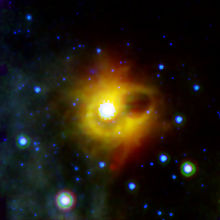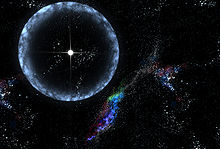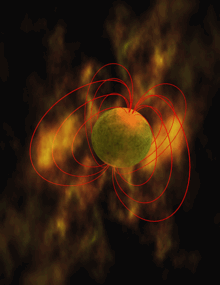- Magnetar
-
A magnetar is a type of neutron star with an extremely powerful magnetic field, the decay of which powers the emission of copious amounts of high-energy electromagnetic radiation, particularly X-rays and gamma rays.[1] The theory regarding these objects was proposed by Robert Duncan and Christopher Thompson in 1992, but the first recorded burst of gamma rays thought to have been from a magnetar was detected on March 5, 1979.[2] During the following decade, the magnetar hypothesis has become widely accepted as a likely explanation for soft gamma repeaters (SGRs) and anomalous X-ray pulsars (AXPs).
Contents
Description
Little is known about the physical structure of magnetars because none are sufficiently close to Earth to facilitate study. Like other neutron stars, magnetars are around 20 kilometres (12 mi) in diameter but have a greater mass than the Sun. The density of a magnetar is such that a thimbleful of its substance, sometimes referred to as neutronium, would have a mass of over 100 million tons.[1] Magnetars are differentiated from other neutron stars by having even stronger magnetic fields, and rotating comparatively slowly, with most magnetars completing a rotation once every one to ten seconds.[3] compared to less than one second for a typical neutron star. This magnetic field gives rise to very strong and characteristic bursts of X-rays and gamma rays. The active life of a magnetar is short. Their strong magnetic fields decay after about 10,000 years, after which activity and strong X-ray emission cease. Given the number of magnetars observable today, one estimate puts the number of inactive magnetars in the Milky Way at 30 million or more.[3]
Starquakes triggered on the surface of the magnetar cause great volatility in the star and the magnetic field which encompasses it, often leading to extremely powerful gamma ray flare emissions which have been recorded on Earth in 1979, 1998, and 2004.[4]
Magnetic field
Magnetars are primarily characterized by their extremely powerful magnetic field, which can often reach the order of ten gigateslas. These magnetic fields are hundreds of millions of times stronger than any man-made magnet,[5] and quadrillions of times more powerful than the field surrounding Earth.[6] Earth has a geomagnetic field of 30–60 microteslas, and a neodymium-based, rare-earth magnet has a field of about 1 tesla, with a magnetic energy density of 4.0×105 J/m3. A 10 gigatesla field, by contrast, has an energy density of 4.0×1025 J/m3, with an E/c2 mass density >104 times that of lead. The magnetic field of a magnetar would be lethal even at a distance of 1000 km, tearing tissues due to the diamagnetism of water[citation needed]. At a distance halfway to the moon, a magnetar could strip information from all credit cards on Earth.[7] As of 2010[update], they are the most magnetic objects ever detected in the universe.[4][8]
As described in the February 2003 Scientific American cover story, remarkable things happen within a magnetic field of magnetar strength. "X-ray photons readily split in two or merge together. The vacuum itself is polarized, becoming strongly birefringent, like a calcite crystal. Atoms are deformed into long cylinders thinner than the quantum-relativistic de Broglie wavelength of an electron."[2] In a field of about 105 teslas atomic orbitals deform into rod shapes. At 1010 teslas, a hydrogen atom becomes a spindle 200 times narrower than its normal diameter.[2] Currently, the mechanism which generates such strong magnetic fields, if they exist, is unknown.
Formation
 Magnetar SGR 1900+14 is in the exact center of the image, which shows a surrounding ring of gas seven light-years across in infrared light, as seen by the Spitzer Space Telescope. The magnetar itself is not visible at this wavelength, but it has been seen in X-ray light.
Magnetar SGR 1900+14 is in the exact center of the image, which shows a surrounding ring of gas seven light-years across in infrared light, as seen by the Spitzer Space Telescope. The magnetar itself is not visible at this wavelength, but it has been seen in X-ray light.
When, in a supernova, a star collapses to a neutron star, its magnetic field increases dramatically in strength. Halving a linear dimension increases the magnetic field fourfold. Duncan and Thompson calculated that, when the spin, temperature and magnetic field of a newly formed neutron star falls into the right ranges, a dynamo mechanism could act, converting heat and rotational energy into magnetic energy, and increasing the magnetic field, normally an already enormous 108 teslas to more than 1011 teslas (or 1015 gauss). The result is a magnetar.[9] It is estimated that about one in ten supernova explosions results in a magnetar rather than a more standard neutron star or pulsar.[10]
1979 discovery
On March 5, 1979, a few months after the successful dropping of satellites into the atmosphere of Venus, the two Soviet spacecraft that were then drifting through the solar system were hit by a blast of gamma ray radiation at approximately 10:51 EST. This contact raised the radiation readings on both the probes from a normal 100 counts per second to over 200,000 counts a second, in only a fraction of a millisecond.[2]
This burst of gamma rays quickly continued to spread. Eleven seconds later, Helios 2, a NASA probe, which was in orbit around the Sun, was saturated by the blast of radiation. It soon hit Venus, and the Pioneer Venus Orbiter's detectors were overcome by the wave. Seconds later, Earth received the wave of radiation, where the powerful output of gamma rays inundated the detectors of three U.S. Department of Defense Vela satellites, the Soviet Prognoz 7 satellite, and the Einstein Observatory. Just before the wave exited the solar system, the blast also hit the International Sun-Earth Explorer. This extremely powerful blast of gamma ray radiation constituted the strongest wave of extra-solar gamma rays ever detected; it was over 100 times more intense than any known previous extra-solar burst. Because gamma rays travel at the speed of light and the time of the pulse was recorded by several distant spacecraft as well as on Earth, the source of the gamma radiation could be calculated to an accuracy of about 2 arcseconds.[11] The direction of the source corresponded with the remnants of a star that had gone supernova around 3000 B.C.[4]
Recent discoveries
On February 21, 2008 it was announced that NASA and researchers at McGill University had discovered a neutron star with the properties of a radio pulsar which emitted some magnetically-powered bursts, like a magnetar. This suggests that magnetars are not merely a rare type of pulsar but may be a (possibly reversible) phase in the lives of some pulsars.[12] On September 24, 2008, ESO announced what it believed was the first optically active magnetar-candidate yet discovered, using ESO's Very Large Telescope. The newly discovered object was designated SWIFT J195509+261406.[13]
Known magnetars
 On 27 December 2004, a burst of gamma rays arrived in our solar system from SGR 1806-20 (artist's conception shown). The burst was so powerful that it had effects on Earth's atmosphere, at a range of over 50,000 light years.
On 27 December 2004, a burst of gamma rays arrived in our solar system from SGR 1806-20 (artist's conception shown). The burst was so powerful that it had effects on Earth's atmosphere, at a range of over 50,000 light years.
As of April 2011[update], twenty one magnetars are known, with five more candidates awaiting confirmation[citation needed]. Examples of known magnetars include:
- SGR 1806-20, located 50,000 light-years from Earth on the far side of our Milky Way galaxy in the constellation of Sagittarius.
- SGR 1900+14, located 20,000 light-years away in the constellation Aquila. After a long period of low emissions (significant bursts only in 1979 and 1993) it became active in May-August 1998, and a burst detected on August 27, 1998 was of sufficient power to force NEAR Shoemaker to shut-down to prevent damage and to saturate instruments on BeppoSAX, WIND and RXTE. On May 29, 2008, NASA's Spitzer telescope discovered a ring of matter around this magnetar. It is thought that this ring formed in the 1998 burst.[14]
- SGR 0501+4516 was discovered on Aug. 22, 2008[15]
- 1E 1048.1-5937, located 9,000 light-years away in the constellation Carina. The original star, from which the magnetar formed, had a mass 30 to 40 times that of the Sun.
- As of September 2008[update], ESO reports identification of an object which it has initially identified as a magnetar, SWIFT J195509+261406, originally identified by a gamma-ray burst (GRB 070610)[13]
- CXO J164710.2-455216, located in the massive galactic cluster Westerlund 1, which formed from a star with a mass in excess of 40 solar masses.[16]
A full listing is given in the McGill SGR/AXP Online Catalog.[17]
See also
References
- Specific
- ^ a b Ward; Brown lee, p.286
- ^ a b c d Kouveliotou, C.; Duncan, R. C.; Thompson, C. (February 2003). "Magnetars". Scientific American; Page 35.
- ^ a b "Magnetars, Soft Gamma Repeaters and Very Strong Magnetic Fields". Robert C. Duncan, University of Texas at Austin. March 2003. http://solomon.as.utexas.edu/~duncan/magnetar.html#Epilog. Retrieved 2007-05-23.
- ^ a b c Kouveliotou, C.; Duncan, R. C.; Thompson, C. (February 2003). "Magnetars". Scientific American; Page 36.
- ^ "HLD user program, at Dresden High Magnetic Field Laboratory". http://www.fzd.de/db/Cms?pNid=1482. Retrieved 2009-02-04.
- ^ Naye, Robert. "The Brightest Blast". http://www.skyandtelescope.com/news/3310066.html?page=1&c=y. Retrieved 17 December 2007.
- ^ "Cosmic Explosion Among the Brightest in Recorded History". http://www.nasa.gov/vision/universe/watchtheskies/swift_nsu_0205.html. Retrieved 17 December 2007.
- ^ ""Magnetar" discovery solves 19-year-old mystery". http://science.nasa.gov/newhome/headlines/ast20may98_1.htm. Retrieved 17 December 2007.
- ^ Kouveliotou, p.237
- ^ S. B. Popov, M. E. Prokhorov, Progenitors with enhanced rotation and the origin of magnetars. Monthly Notices of the Royal Astronomical Society 367 (2), 732–736.
- ^ Cline, T. L., Desai, U. D., Teegarden, B. J., Evans, W. D., Klebesadel, R. W., Laros, J. G., (Apr. 1982). "Precise source location of the anomalous 1979 March 5 gamma-ray transient". Journal: Astrophysical Journal 255: L45–L48. Bibcode 1982ApJ...255L..45C. doi:10.1086/183766.
- ^ Jekyll-Hyde neutron star discovered by researchers McGill
- ^ a b "First Optically Active Magnetar-Candidate Discovered". http://www.eso.org/public/outreach/press-rel/pr-2008/pr-31-08.html. Retrieved 25 September 2008.
- ^ "Strange Ring Found Around Dead Star". http://science.nasa.gov/headlines/y2008/29may_magnetar.htm?list793087.
- ^ Francis Reddy, European Satellites Probe a New Magnetar (NASA SWIFT site, 06.16.09)
- ^ Westerlund 1: Neutron Star Discovered Where a Black Hole Was Expected
- ^ "McGill SGR/AXP Online Catalog". http://www.physics.mcgill.ca/~pulsar/magnetar/main.html. Retrieved 22 June 2011.
- Books and literature
- Peter Douglas Ward, Donald Brownlee Rare Earth: Why Complex Life Is Uncommon in the Universe. Springer, 2000. ISBN 0387987010.
- Chryssa Kouveliotou The Neutron Star-Black Hole Connection. Springer, 2001. ISBN 140200205X.
- Mereghetti, S. (2008). "The strongest cosmic magnets: soft gamma-ray repeaters and anomalous X-ray pulsars". Astronomy and Astrophysics Review 15 (4): 225–287. Bibcode 2008A&ARv..15..225M. doi:10.1007/s00159-008-0011-z. Archived from the original on 1 April 2008. http://arxiv.org/abs/0804.0250.
- General
- "Origin of magnetars". CNN. 2 February 2005. http://www.cnn.com/2005/TECH/space/02/01/universe.magnets/index.html.
- "The Brightest Blast". Sky and Telescope. 18 February 2005. http://skyandtelescope.com/news/article_1464_1.asp.
External links
- Recording (and animation) of XTE J1810-197.
- Creation of magnetars solved Formed when the biggest stars explode
- NASA: "Magnetar" discovery solves 19-year-old mystery Citat: "...suggested a magnetic field strength of about 800 trillion [g]auss...").
- Robert C. Duncan, University of Texas at Austin: 'Magnetars', Soft Gamma Repeaters & Very Strong Magnetic Fields
- NASA Astrophysics Data System (ADS): Duncan & Thompson, Ap.J. 392, L9) 1992
- NASA Astrophysics Data System (ADS): Katz, J. I., Ap.J. 260, 371 (1982)
- NASA ADS, 1999: Discovery of a Magnetar Associated with the Soft Gamma Repeater SGR 1900+14
- Chryssa Kouveliotou, Robert C. Duncan, and Christopher Thompson, "Magnetars," Scientific American, Feb. 2003, pp. 34-41 (PDF)
- Robert C. Duncan and Christopher Thompson (June 10, 1992). "Formation of Very Strongly Magnetized Neutron Stars: Implications for Gamma-Ray Bursts". Astronomical Journal 392 (1): L9–L13. Bibcode 1992ApJ...392L...9D. doi:10.1086/186413. http://adsbit.harvard.edu/cgi-bin/nph-iarticle_query?bibcode=1992ApJ...392L...9D.
- Strange Pulsing Star Puzzles Astronomers - A magnetar found to emit radio waves, contrary to previous theories.
- 04/04/07: X-ray Satellites Catch Magnetar in Gigantic Stellar 'Hiccup'
- "Magnetars" (Paper on magnetar formation from March 1995 conference proceedings, suggesting that AXPs are magnetars.)
Neutron star Types Single pulsars Binary pulsars Properties Neutron-star oscillation · Neutronium · Tolman-Oppenheimer-Volkoff limit · Rp-process · Gamma-ray burst · Optical · Timing noise · Relativistic · Glitch · Pulsar kicks · Bondi accretion · Quasi-periodic oscillations · Urca process · StarquakeRelated Compact star (Quark star · Exotic star) · Supernova (Supernova remnant · Related links) · Hypernova · Quark nova · White dwarf (Related links) · Stellar black hole (Related links) · Radio star · Pulsar planet · Pulsar wind nebula · Thorne-Żytkow objectDiscovery Satellite Investigation of Other Supernovae Classes Related - Near-Earth supernova
- Supernova impostor
- Hypernova
- Quark-nova
- Pulsar kicks
Structure Progenitors Remnants Discovery Lists - Notable supernovae
- Supernova remnants
- Candidates
- Massive stars
- In fiction
Notable Research Categories:- Star types
- Magnetars
- Stellar phenomena
Wikimedia Foundation. 2010.

